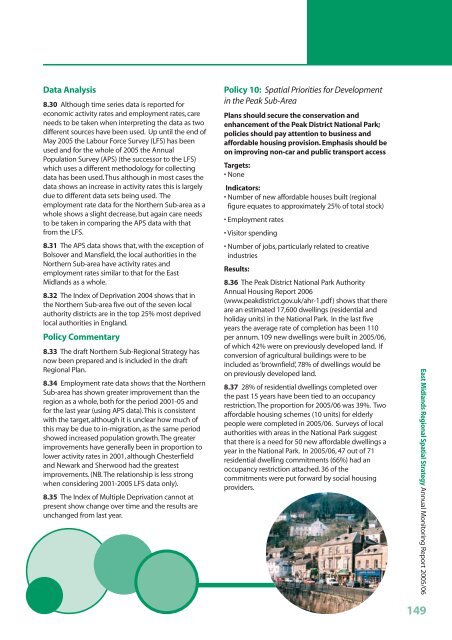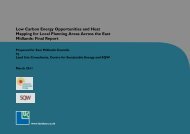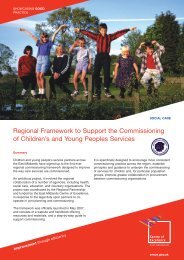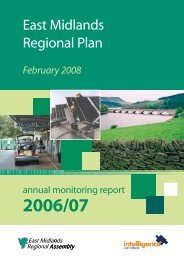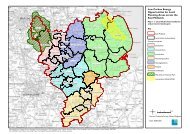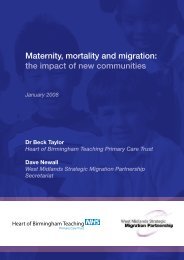East Midlands Regional Spatial Strategy 2005/06
East Midlands Regional Spatial Strategy 2005/06
East Midlands Regional Spatial Strategy 2005/06
You also want an ePaper? Increase the reach of your titles
YUMPU automatically turns print PDFs into web optimized ePapers that Google loves.
Data Analysis<br />
8.30 Although time series data is reported for<br />
economic activity rates and employment rates, care<br />
needs to be taken when interpreting the data as two<br />
different sources have been used. Up until the end of<br />
May <strong>2005</strong> the Labour Force Survey (LFS) has been<br />
used and for the whole of <strong>2005</strong> the Annual<br />
Population Survey (APS) (the successor to the LFS)<br />
which uses a different methodology for collecting<br />
data has been used.Thus although in most cases the<br />
data shows an increase in activity rates this is largely<br />
due to different data sets being used. The<br />
employment rate data for the Northern Sub-area as a<br />
whole shows a slight decrease, but again care needs<br />
to be taken in comparing the APS data with that<br />
from the LFS.<br />
8.31 The APS data shows that, with the exception of<br />
Bolsover and Mansfield, the local authorities in the<br />
Northern Sub-area have activity rates and<br />
employment rates similar to that for the <strong>East</strong><br />
<strong>Midlands</strong> as a whole.<br />
8.32 The Index of Deprivation 2004 shows that in<br />
the Northern Sub-area five out of the seven local<br />
authority districts are in the top 25% most deprived<br />
local authorities in England.<br />
Policy Commentary<br />
8.33 The draft Northern Sub-<strong>Regional</strong> <strong>Strategy</strong> has<br />
now been prepared and is included in the draft<br />
<strong>Regional</strong> Plan.<br />
8.34 Employment rate data shows that the Northern<br />
Sub-area has shown greater improvement than the<br />
region as a whole, both for the period 2001-05 and<br />
for the last year (using APS data).This is consistent<br />
with the target, although it is unclear how much of<br />
this may be due to in-migration, as the same period<br />
showed increased population growth.The greater<br />
improvements have generally been in proportion to<br />
lower activity rates in 2001, although Chesterfield<br />
and Newark and Sherwood had the greatest<br />
improvements. (NB.The relationship is less strong<br />
when considering 2001-<strong>2005</strong> LFS data only).<br />
8.35 The Index of Multiple Deprivation cannot at<br />
present show change over time and the results are<br />
unchanged from last year.<br />
Policy 10: <strong>Spatial</strong> Priorities for Development<br />
in the Peak Sub-Area<br />
Plans should secure the conservation and<br />
enhancement of the Peak District National Park;<br />
policies should pay attention to business and<br />
affordable housing provision. Emphasis should be<br />
on improving non-car and public transport access<br />
Targets:<br />
• None<br />
Indicators:<br />
• Number of new affordable houses built (regional<br />
figure equates to approximately 25% of total stock)<br />
• Employment rates<br />
• Visitor spending<br />
• Number of jobs, particularly related to creative<br />
industries<br />
Results:<br />
8.36 The Peak District National Park Authority<br />
Annual Housing Report 20<strong>06</strong><br />
(www.peakdistrict.gov.uk/ahr-1.pdf) shows that there<br />
are an estimated 17,600 dwellings (residential and<br />
holiday units) in the National Park. In the last five<br />
years the average rate of completion has been 110<br />
per annum. 109 new dwellings were built in <strong>2005</strong>/<strong>06</strong>,<br />
of which 42% were on previously developed land. If<br />
conversion of agricultural buildings were to be<br />
included as ‘brownfield’, 78% of dwellings would be<br />
on previously developed land.<br />
8.37 28% of residential dwellings completed over<br />
the past 15 years have been tied to an occupancy<br />
restriction.The proportion for <strong>2005</strong>/<strong>06</strong> was 39%. Two<br />
affordable housing schemes (10 units) for elderly<br />
people were completed in <strong>2005</strong>/<strong>06</strong>. Surveys of local<br />
authorities with areas in the National Park suggest<br />
that there is a need for 50 new affordable dwellings a<br />
year in the National Park. In <strong>2005</strong>/<strong>06</strong>, 47 out of 71<br />
residential dwelling commitments (66%) had an<br />
occupancy restriction attached. 36 of the<br />
commitments were put forward by social housing<br />
providers.<br />
<strong>East</strong> <strong>Midlands</strong> <strong>Regional</strong> <strong>Spatial</strong> <strong>Strategy</strong> Annual Monitoring Report <strong>2005</strong>/<strong>06</strong><br />
149


